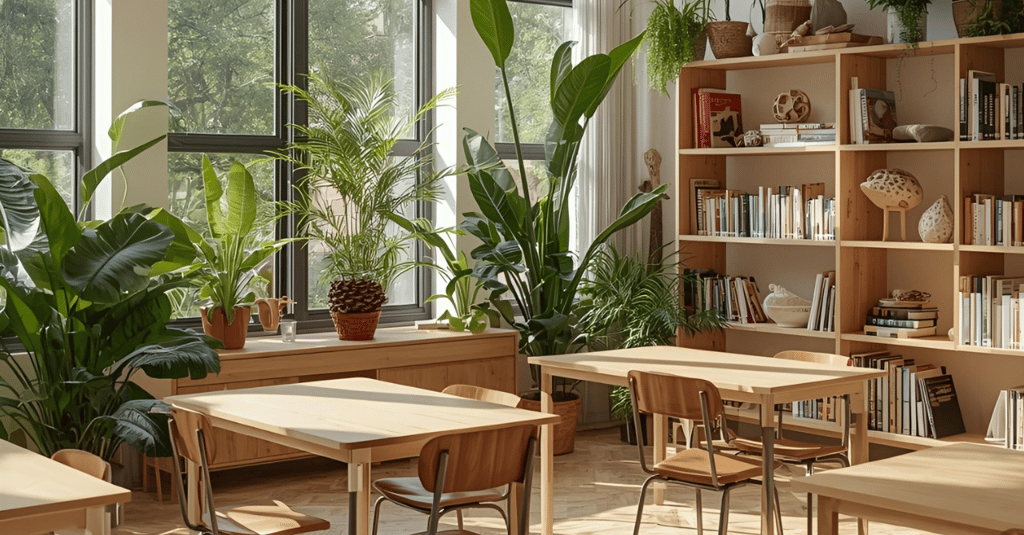Rethinking Classroom Design
Jocelyn Mayo
9/3/20253 min read


Rethinking the Classroom: how modern learning spaces shape learning and mental health
Step into most classrooms today and you’ll notice something familiar: rows of desks, bright displays, and a teacher at the front. Despite huge advances in what we know about how children learn, many classrooms look little different from those of 30 years ago.
But recent research is clear: the environment itself is an active ingredient in learning and wellbeing. Design choices influence not only test scores, but also stress levels, attention, behaviour, and even resilience.
This matters for all learners—but it is especially critical for children with ADHD, autism, or executive function difficulties, who are more vulnerable to sensory overload and environmental stress.
Here are four design priorities backed by the latest evidence.
1. Air, Light and Sound: the invisible drivers of learning
Recent reviews (2023) of over 170 studies confirm that classroom air quality, light, noise, and temperature all measurably affect children’s cognition and health.
Air: High CO₂ and pollutants reduce attention, energy, and decision-making. Children are more sensitive than adults, making clean, well-ventilated air essential.
Light: Children prefer bright, natural daylight. Proper lighting reduces fatigue and boosts alertness, but glare control is vital for sensory-sensitive learners.
Sound: Background noise and long reverberation times are strongly linked with poorer language processing and attention—especially for those with ADHD or autism.
Quick wins for schools: monitor CO₂ levels, maintain ventilation, add soft acoustic finishes, and manage glare with blinds or diffusers.
2. Nature and Green Space: a mental health superpower
Perhaps the most exciting new findings come from nature-based interventions. Studies in 2023–25 show that even modest doses of greenery and outdoor learning lead to:
Lower stress and anxiety
Improved mood and positive affect
Better social connection and reduced antisocial behaviour
Gains in attention and working memory in some groups
The evidence is so strong that some researchers now describe green space as a protective factor for children’s mental health. A few studies even suggest links with higher IQ, though this remains an emerging area of research.
Practical steps:
Schedule weekly outdoor lessons, not just PE.
Plant hardy greenery in and around classrooms.
Use biophilic design—wood textures, nature motifs—where outdoor access is limited.
3. Flexible Space and Movement: supporting energy and focus
Rigid rows of desks don’t reflect the diversity of learners—or the way attention and regulation really work. Movement and flexibility help all children, but especially those with ADHD who need constructive outlets for restlessness. However, careful classroom management is required to ensure optimal learning for all, and teachers know first-hand how challenging this can be.
Standing desks: Pilots in UK and US schools show that standing desks consistently reduce sedentary time. Some studies suggest they may support on-task behaviour, though UK trials also highlight potential challenges with classroom management if standing desks are used by every pupil without clear routines.
Posture choice: Options like perch stools, wobble cushions, and soft floor seating give learners autonomy in how they work.
Learning zones: Creating micro-spaces—quiet nooks, collaboration hubs, presentation corners—lets students choose an environment that matches the task and their regulation needs.
Opportunities for movement are important, but the challenge is how to introduce them without disruption to learning.
4. School Climate: the social environment matters too
The physical space is only one side of the equation. The social-emotional climate of the school has powerful effects on mental health.
A longitudinal UK study (2023) found that a positive school climate predicted fewer emotional and behavioural problems three years later.
Another (2025) showed that climate boosts resilience, which in turn reduces anxiety and depression and increases life satisfaction.
In practice, this means that classrooms designed for connection—where students feel a sense of belonging, voice, and safety—act as protective environments for mental health
Practical steps:
Involve students in shaping and caring for their environment.
Design spaces for both community and retreat.
Train staff to balance high expectations with high relational support.
What Progressive Schools Are Doing
New Zealand: After experimenting with open-plan “super classrooms,” schools are moving back toward enclosed but flexible rooms—balancing collaboration with acoustic control.
Scandinavia: Schools like Vittra Telefonplan in Stockholm design “learning landscapes” with zones for different modes of learning.
UK pilots: Schools trialling standing desks and outdoor learning sessions are reporting calmer classrooms, higher engagement, and stronger wellbeing.
Final Thought: time for an environment audit
Classrooms are not neutral. They can amplify stress—or create the conditions where every learner thrives.
The latest evidence is clear: fresh air, natural light, green space, flexible movement, and a positive climate are not luxuries. They are necessities.
We are long overdue for a review of school learning environments—not as an afterthought, but as a central part of our strategy for learning, inclusion, and wellbeing.
References
Barrett, P. et al. (2013). The impact of classroom design on pupils’ learning. Building and Environment.
Wang, L. et al. (2023). Impacts of indoor environmental quality on children’s health in classrooms: A systematic review. Science of The Total Environment.
Chawla, L. et al. (2024). School-led nature interventions and child wellbeing: A systematic review. Educational Psychologist.
García-Coll, V. et al. (2025). School climate, resilience, and adolescent mental health. Journal of Adolescence.
The Guardian (2024, 2025). Coverage on green space and children’s outdoor play.
OECD (2013). Innovative Learning Environments.




